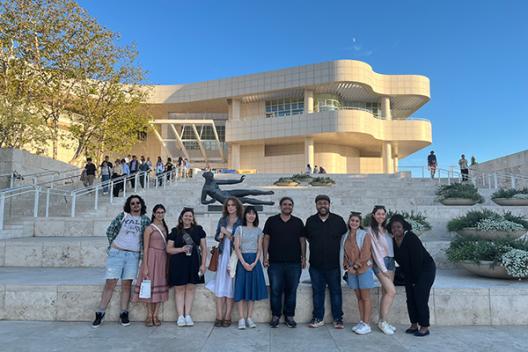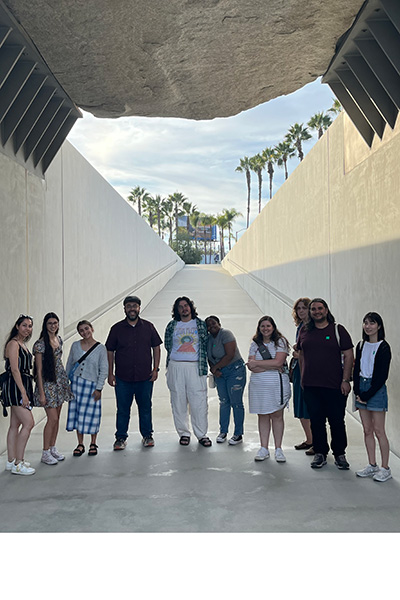
During autumn break 2024, students enrolled in my "HISTART 8561: Early Modern Art History and Cultural Encounter" graduate seminar embarked on a research trip to Los Angeles, designed to immerse students in the city’s rich and diverse museum scene and archival collections. The class is designed to introduce students to a broad number of issues in the field of Early Modern studies, especially as they relate to nonwestern visual, material and intellectual cultural production. In anticipation of this trip, several in-class discussions were devoted to museum studies and the politics of display. Over a period of nearly four days, students had the opportunity to engage deeply with significant art collections, research archives and iconic cultural institutions that have transformed LA into a global center for the study of art. This trip aimed to foster both appreciation for and critical awareness of such cultural centers while encouraging graduate students to make connections with their own studies and research interests. When we arrived at LAX on Wednesday afternoon, we had already spent some time in class overviewing the major museums we were going to visit — The Getty, LACMA and The Broad — including their history, their collections and their general impact on Los Angeles. We were eager to get started, which we were going to do the next day after settling into our hotel in Koreatown.
Thursday was dedicated to the Getty Center, a key highlight of the trip. We woke up bright and early to visit the Getty Research Institute (GRI), where students had access to invaluable archival and research materials useful for their final papers for the class. Prior to leaving Columbus, they had selected materials to be pulled from the GRI’s Special Collections. As we rode the tram to the Getty Center’s iconic, hilltop campus in the Santa Monica Mountains, we took in impressive views of the city and the I-405 below. Once at the GRI, we had a room reserved for our class with all of the material requested on display. It was a fantastic opportunity for hands-on learning and for experiencing first-hand the work of what early modernists do, as students engaged with centuries-old documents, books and paintings. One student was interested in learning more about the history of collections (such as J. Paul Getty’s), and we had pulled for us a scrapbook that belonged to Getty himself.
The afternoon was spent exploring the J. Paul Getty Museum. Surrounded by the museum’s impressive architecture, stunning gardens and breathtaking views of Bel Air and Brentwood, students delved into collections spanning European paintings, sculptures and decorative arts. At the time of our visit, there were several special exhibitions devoted to the theme of “light.” Of special note was Lumen: The Art and Science of Light, which showcased how the science of light was studied in the medieval world, as well as an exhibit devoted to holographic imagery, and a one-room exhibit showing the results of the Getty Conservation Institute’s infrared studies on Van Gogh’s Irises.

On Friday, we visited the Los Angeles County Museum of Art (LACMA) in Museum Row in the center of LA’s Mid-Wilshire district. Students got to see the massive, ongoing expansion of LACMA and the underground Metro line and station, all set to open in advance of the 2028 Olympics. As the entire site remains a construction zone, much of LACMA’s permanent collection was not on display, but we still engaged closely with The Nature of Color in Mesoamerican Art, an exhibit exploring (through technical and material analysis) the science, art and cosmology of color in Mesoamerica, as well as the LACMA’s contemporary art collection. Many students had lunch in Little Ethiopia just south of the museum. Before heading back to our hotel in the afternoon, we experienced Michael Heizer’s Levitating Mass, a 340-ton boulder placed above a viewing pathway that has become an iconic large-scale public sculpture in the city.
On Saturday, we headed to our last destination together, The Broad contemporary art museum in downtown Los Angeles. The museum is named for philanthropists Eli and Edythe Broad, who paid for the $140 million building (occupying a full city block) to house their impressive collection of contemporary art in addition to rotating exhibitions. While at The Broad, we had serious discussions contemplating the meaning (and ethics) of individual pieces of art as well as how museums contribute to canon-formation of specific artists, styles and general trends. After The Broad, some students stayed downtown and visited MOCA, while others visited other museums such as the Getty Villa in Malibu.
We headed back to Columbus on a very early morning flight. Although we were exhausted, we reflected on how much we saw in very little time. The trip was a testament to the value of integrating travel into the academic curriculum, offering our graduate students an unparalleled opportunity to connect classroom learning with real-world experiences.
